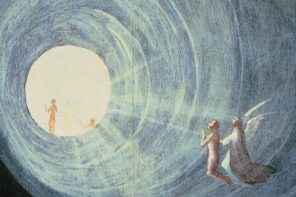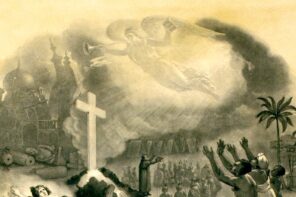Believer is not your average religion documentary, offering an outsider’s view of the spectacle of belief. Instead, Reza Aslan’s upcoming “spiritual adventure series” for CNN follows this noted Muslim-American religious scholar as he immerses himself in the experience and practice of widely misunderstood religions.
From the ascetic Aghori in India to Vodou in Haiti, from the doomsday cult of “JeZus with a Z” in Hawaii to Scientology in America and Santa Muerte in Mexico, the series takes viewers on an intriguing, and sometimes harrowing, tour of religion in real time—as far from orthodoxy as you can get.
A couple of weeks ahead of the show’s March 5th premiere, Reza and I talked about the decline of religious literacy, Santa Muerte and immigration, why institutional religion is really about control, and how to break through the myths and symbols of religious difference to find common ground.
______
Kaya Oakes: What was the impulse to do this series as a television show? What can TV show us about religion that a book can’t?
Reza Aslan: My entire career has been built around trying to give people a better sense of what religion is—not just more knowledge about the world’s religions, but more knowledge about even how to understand religion, how to put it in its historical context. Also, how to understand the difference between what is sometimes referred to as “high” religion and low religion—the religion of scripture and temples and priesthood versus the actual lived religion that people experience in their day to day lives.
I do that through books, talks, and television interviews, but I can’t think of a better medium than TV in order to really drive this point home. I’m a firm believer in the power that television has to change the way people even think. And so I’ve been developing this idea for years, to go around the word and immerse myself in other religious traditions and other religious communities to give people a window into unfamiliar belief systems.
That, more than anything else, will help people— more than any book I could write—to understand that we’re not all that different. We may have different names for God, we may use different rituals and different practices to address all of our faiths, but in the end but there isn’t all that much difference in the way that we think about these sort of larger questions.
There’s always a bit of danger—as I’ve learned in my own work—when you’re writing about different religions, especially esoteric or less well-known ones like those you focus on in the series, that people might say: “Oh, you’re just doing religious tourism.” How did you work to avoid that?
First and foremost I wanted to make sure this series was experiential, not just informative. There are a lot of shows out there—”The Story of God“—was a popular version of this, of people going around the world and basically pointing at religious groups and saying, “Look at that, isn’t that interesting!”
I didn’t want to do that. I wanted to say I’m not here to talk about you, I’m here to become a part of you.
It was very difficult, because these religions that we explore in the first season are insular, are secretive. Many of them are profoundly suspicious of outsiders. I won’t lie: it took some time to earn their trust. I had the advantage of having a little bit of a reputation—people had heard of me and knew I wasn’t there to make fun of them. I wasn’t there to mock them or to judge them, I was there to understand them. That helped a lot.
Once they opened themselves up it was really easy for me to feel like I belonged. Anyone who watches will get sense right away that this is not just tourism. Even at those times when it’s difficult, and even at those times when I have to really overcome some personal obstacles to fully immerse myself, even in those times, if you watch it you get a sense that there’s something authentic going on here.
I’m not a good enough actor to pretend these emotions—so what you see is what’s actually happening.

Looking for a dissertation topic?
I wanted to ask specifically about the Santa Muerte episode because I live in California too, and I’ve seen her in botanicas and shrines. You spend a lot of time focusing on how this new religion of Santa Muerte is especially appealing to the most marginalized people in Mexico. How does that speak to our moment with immigration?
Santa Muerte was probably my favorite episode, both at the level of experience but also from my perspective as a scholar. I felt as though I were witnessing a brand new religion coming into its own, becoming a global religion, creating from scratch its own rituals, its own mass.
The Santa Muerte mass in that episode is remarkable. Anyone familiar with the Catholic mass will recognize some of the words that they’re using, but the words here are just a little bit different. And they are geared toward the concerns that the kind of people who are drawn to Santa Muerte feel—the outcasts, the people on the margins, people who feel they’ve been left behind by the church, or who don’t even belong to the church. It was extraordinary to see that happen before my eyes.
But if you live in the southern states of the United States, you’ve seen Santa Muerte. You’ve seen the icons of this skeleton wearing a dress and probably said to yourself, “What the hell is that?” And it’s a big religion. I’ve seen estimates between 5-10 million adherents in Mexico and America. But of course, migration patterns have transformed Santa Muerte’s reach, so now there are dozens of Santa Muerte temples in the United States. There are two significant ones here just in Los Angeles. There’s a very big one in New York, and there are lots of them throughout Arizona and Nevada and Texas.
So for those people out there who want to write a PhD in religion, pick this one: you’re watching in real time the creation and spread of a new global religion primarily due to shifting migration patterns. That’s how Christianity became a global religion: people left the confines of the Roman Empire and took Christianity with them. That’s how Islam became a global religion: people left the confines of the Arabian Peninsula and took Islam with them. And that’s what’s happening now.
What we discovered was that a great many undocumented immigrants who make the long, perilous journey from Latin America and Mexico to the United States, before they do so, they make a vow to Santa Muerte, make peace with Saint Death. They say to themselves, “I may not make this, there’s a good chance I may die on the way. If I make it to America, I vow that I’ll set up an idol or temple for Santa Muerte.”
And that’s precisely why you see so many shrines in the southern United States—because the people who create them are fulfilling a vow. It tells you so much about how religion works, and this religion in particular. It’s really fascinating.
We have a pope who’s extremely popular with immigrants. But even though people will turn out for the pope in Mexico, they don’t go to mass and they’ve lost confidence in the church as an institution. And this new religion that’s led mostly by women is really powerful—but it speaks to the decline of the Catholic church.
Mexico to this day remains the most Catholic country on the planet and yet there’s no question Santa Muerte is beginning to put a real dent in that.
Now what’s really fascinating to me is that a great many adherents of Santa Muerte will say: “We’re Catholics, but with an extra saint.” But there are just as many adherents of Santa Muerte who will absolutely deny that and say this has nothing to do with Catholicism. Sure Santa Muerte looks like the Virgin of Guadeloupe but as a skeleton, or the mass that we do is taken almost completely from the Catholic mass with slightly different words, or they’ll say Catholicism was stolen from us, that what we are following is an ancient religion that was here long before the Catholics showed up and forced us to worship Christ.
What’s remarkable and truly a lesson for what it takes to actually succeed is that it’s individualized—there seems to be no center for Santa Muerte. It’s whatever people want it to be.
Whereas a global religion like Catholicism which is carefully controlled by a center—the Vatican, the pope as the sole spokesman for the religion —it makes it that much more difficult for the church to change and shift and evolve to changing times. Part of why Catholicism is stagnant in Mexico and Santa Muerte is ascendant is that Santa Muerte has the ability to respond to the changing needs of Mexicans in an instant, whereas Catholicism doesn’t.
Santa Muerte is a little speedboat and Catholicism is an ocean liner—it takes about a day for an ocean liner to make a left turn, whereas in that time Santa Muerte’s already done three or four circles.
I spent two years researching and writing about the so-called “Nones,” and part of it is that they still have desire for religious and spiritual practice but they want it to be decentralized, and I kept thinking about that during the Santa Muerte episode. It’s a religious practice that’s adaptive and individualistic and growing so fast, much in the same way the number of “spiritual but not religious” people is growing.
Yes, and the exact same thing is paralleled in Scientology. You have a church that is obsessed with maintaining an absolute iron grip over the religion. If you don’t follow Scientology under the church’s guidance, you’re not really a Scientologist. And that again has led to stagnation, it’s led to a massive drop in members of the church. It has created a church that’s not really built to respond to the immediate global needs of the world’s Scientologists.
So now on the flip side you have now the Scientology reform movements, highly individualized versions of Scientology that people are adopting for their own. Those new versions are spreading at an unbelievable rate. It’s a weird phenomenon where scientology as a religion is flourishing even as Scientology as a church seems to be contracting somewhat. The church of Scientology has an important decision to make: either they try to maintain control over this religion and risk diminishing and eventually fading away, or they give up trying to control it and allow these communities to do Scientology in their own way in some shape or form—and the reward of that is that this religion could take off and become a truly global faith.
It is similar to the backlash against Santa Muerte from the Vatican, where they don’t like people customizing or curating their religious experience.
They really don’t, and there it is right there. Unfortunately, so much of religion, particularly institutional religion, is about control. But that’s just not how it works.
There are a lot of lessons I hope people will draw from these shows, but that’s one of them right there: the difference between institutional religion and lived religion. Because even in a religion like Catholicism in which the core principle is that the pope is infallible and speaks with the power of Christ and his word is final… yeah, really?
I know a lot of Catholics, I know a lot of Catholic priests, I know a lot of Catholic bishops who’ll say, “I will listen to the pope but you know, sometimes he’s wrong, and I’m not going to follow if I feel like it’s wrong.”
And of course Catholics are always talking about the primacy of conscience as their response— you went to Jesuit school and know the drill. But on that note, there is a sense right now that religion is divisive rather than inclusive. And that’s very much an American problem right now. So how can we as religion writers, journalists, TV producers, how can we make the case for religion as a force for good today in a time when it is so divisive?
Religion is capable of profound expressions of compassion and horrific acts of violence. It’s both those things. It’s not uniquely one or the other.
The problem begins with the phrase “religion is.” Because religion is whatever a religious person says it is. So we need to understand that in general, we are tribal, we tend to define ourselves in opposition to one another, we tend to think that our myths and metaphors are real and everyone else’s myths and metaphors are fantasies. It’s just how we think. So if religion is purely subjective the problem starts with the human being.
One of the things I’ve tried to do throughout my career is show that when you break through these specific symbols and metaphors of any religion, when you think of religion itself as more of a language to express faith, then all you really need to do is learn the language to realize that the expression of faith is nearly identical in every way. It’s like if you heard someone speaking German, and you didn’t speak German, you would think they were speaking gibberish. But if you had a German translator, you’d realize they’re just saying the same things that you would say if you were speaking.
I know that sounds somewhat simplistic, but that’s precisely how we need to think. I’ve always thought that my job is to be the translator, to sit there and say, this religion Santa Muerte may look weird and foreign and scary, and after all, it looks like they’re worshipping death, but let me explain the metaphor to you. Let me explain the symbol to you.
Once you understand the metaphor, and once you understand the symbolism, you’ll recognize the sentiment. And you’d realize almost immediately how familiar that sentiment sounds, that actually, you kind of believe the things they do.
If can get that experience out of the viewer, my goal is achieved.
What do we do about this in the face of the decline of religious studies? UC Berkeley just terminated its religious studies major, religious literacy is on the decline. Is this series a kind of answer to some of that loss?
Religious literacy is on the decline at the same time that religious identity is ascendant. That should tell you how crazy this is. The world is becoming more religious, not less religious, but we’re learning less about religion, not more.
A television series like this is designed to meet that need. You’re not going learn it in high school or, increasingly, even in college, so we need people to step into the fray and to bring that education to individuals in a way that’s inclusive and interesting but will bring that sense of knowledge and literacy.
My favorite response about the show when people watch it is is the one in which, after the Haiti episode, for example, they’ll come up to be and be like: “Holy cow, I understand Vodou now and I get it!” Or, “I understand Hinduism now!” Or Scientology. That’s a religion where people know a lot about the controversy but not about the religion. So people watch that episode and say, “I actually get what Scientology is.”
I think that’s what the show is all about, to make up for that lack of religious awareness, but to do so in a fun way.
“Believer with Reza Aslan” premieres on March 5th on CNN at 10pm, EST.





